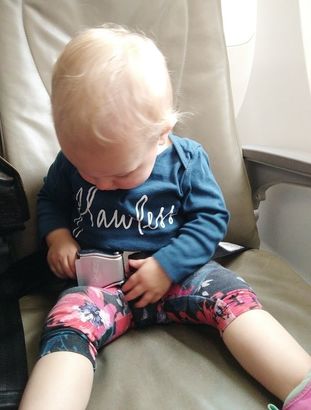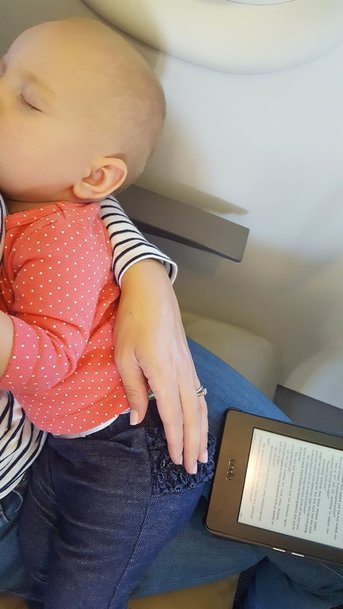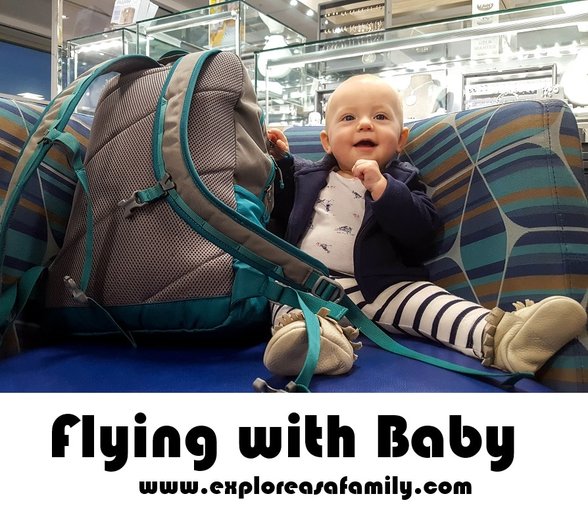Your flight is booked, your luggage is jammed packed and the only thing standing between you and your destination is the flight. Flying can be one of the most nerve racking parts of traveling with kids. Space is at a premium – both in your seat and in those itty bitty airplane bathrooms – and for a lot of people the idea of being trapped at 35,000 feet with an unpredictable little human is enough to cancel the trip before it even starts.
Here is what you need to know to make sure the flight is as smooth and easy as possible:
Here is what you need to know to make sure the flight is as smooth and easy as possible:
Pin it and come back to read the tips later!

Carry Ons
Every adult is entitled to their own carry on (such as a duffle bag or small piece of luggage) and personal item (think backpack, briefcase, or purse). Your infant is entitled to a small carry on (for example, a diaper bag or small cooler) as well. Within your infant's carry on you can pack any flight necessities and any food that your baby might require. Do not hesitate to bring everything you believe you will need up and more (take into account layovers and potential delays) including:
These allowances are fairly standard but it's always a good idea to check with your airline before you leave to see whether they have any specific rules regarding what you are and aren't allowed to check and carry on. This is especially true if your child is over the age of 2 and you want to bring their car seat or another child restraint system on board.
Remember, you can check a car seat free of charge either at the check-in counter or at the gate. A collapsible stroller can also be checked at the gate.
Psst! You may be interested in our two companion posts about what to pack in your carry on - there's one for flying with an infant and one for flying with a toddler!
Every adult is entitled to their own carry on (such as a duffle bag or small piece of luggage) and personal item (think backpack, briefcase, or purse). Your infant is entitled to a small carry on (for example, a diaper bag or small cooler) as well. Within your infant's carry on you can pack any flight necessities and any food that your baby might require. Do not hesitate to bring everything you believe you will need up and more (take into account layovers and potential delays) including:
- boiled or distilled water for bottles,
- formula,
- breast milk or whole milk
- pureed baby food and other snacks (stick to store bought).
These allowances are fairly standard but it's always a good idea to check with your airline before you leave to see whether they have any specific rules regarding what you are and aren't allowed to check and carry on. This is especially true if your child is over the age of 2 and you want to bring their car seat or another child restraint system on board.
Remember, you can check a car seat free of charge either at the check-in counter or at the gate. A collapsible stroller can also be checked at the gate.
Psst! You may be interested in our two companion posts about what to pack in your carry on - there's one for flying with an infant and one for flying with a toddler!

Bassinets
If your baby is under 25 pounds and cannot yet sit independently, consider reserving the bulkhead seat and requesting a bassinet. If your baby sleeps well and independently at home, and you’re flying at their typical bedtime, you might find having the bassinet, and some extra leg room helpful. However, there are some definite downsides. Bulkhead seats lack the under seat storage that you get with a row in front of you, meaning that your luggage is overhead and less accessible. In addition, the arm rests on the seats don’t lift to accommodate the video screens in the arm rests. Both of these factors mean the space feels a little more cramped. Additionally, if the seat belt sign is on, your baby can’t be in the bassinet which means you may end up taking your sleeping baby in and out of the bassinet multiple times on a bumpy flight.
What to Wear
Dress is layers. Planes can vary from very hot to very cold all within the same flight! I tend to wear comfortable pants, a tshirt, and a long sleeved shirt or sweater (depending on what I think I’ll need at my destination). I wear socks and comfortable shoes and pack my sandals in my luggage (they take up less space!).
Where to Sit
If you have the ability to preselect your seats there are a few options to consider. We prefer to be close to the back of a section - either close to the back of the plane or close to the middle of the plane where the main doors and a set of bathrooms are (depending on the size of the plane). This allows for easy access to the bathrooms, as well as to areas to stand if your baby is in the carrier. Being near the back of the plane allows you to be closer to the flight attendants in case you need help, water, coffee or someone to hold your baby while you go to the bathroom!
We also prefer to have at least one parent sitting in an aisle seat so that we aren't constantly having to ask our seat neighbour to get up when we do. It also allows you easier access to the overhead compartments if you need to grab anything from your bag.
Boarding
Preboarding might sound like a great perk but it's generally not the time you want to board! Depending on the size of your flight, boarding can take 30 minutes or longer, not including the time it takes to close the doors, taxi to the runway and take off. This is precious time that your little one can be burning off their energy in the terminal and not confined to your lap. My recommendation is to board as close to last as possible. In the meantime, try and encourage your little one to crawl or run, do one last diaper change, and fill your water bottle. If you are concerned about whether there will be space in the overhead compartments for your carry on, or if you feel more comfortable if your things are organized well before takeoff, think about sending your partner on the plane first with your bulkiest items.
Flying Time!
I have found take off and landing to be the most challenging parts of flying with a busy baby. Having to have them on your lap, seated and in the burping position for an extended period of time when they really just want to be not sitting still is tough. I find this to be the time when they are the most fussy and I am the most panicky (seriously if they are upset now, how will the next x number of hours go!?!?). Inevitably though, once we are in the air and we can move around, things always seem to work out. While they recommend having the baby in the burping position, you can also breastfeed or bottle feed your baby which can help relieve any pressure that can happen with changes in altitude.
Once you are in the air and the seat belt sign has been turned off you can stand, use your carrier, walk the aisles, change a diaper, or take down your tray table to serve some snacks. Alternate between parents, offer new toys on occasion, walk the aisles if need be and try to squeeze in a little nap time - hopefully all that running and crawling before the flight has tuckered them out! No matter what happens, you will survive and chances are it won't be half as painful as you're anticipating!!
Psst! Me Again! You may also be interested in checking out posts on what to pack in your checked luggage and in your If you're interested, we also have a handy packing checklist available for download!
What parts of getting ready for your flight make you the most nervous? What strategies do you use to make boarding your flight easy!
If your baby is under 25 pounds and cannot yet sit independently, consider reserving the bulkhead seat and requesting a bassinet. If your baby sleeps well and independently at home, and you’re flying at their typical bedtime, you might find having the bassinet, and some extra leg room helpful. However, there are some definite downsides. Bulkhead seats lack the under seat storage that you get with a row in front of you, meaning that your luggage is overhead and less accessible. In addition, the arm rests on the seats don’t lift to accommodate the video screens in the arm rests. Both of these factors mean the space feels a little more cramped. Additionally, if the seat belt sign is on, your baby can’t be in the bassinet which means you may end up taking your sleeping baby in and out of the bassinet multiple times on a bumpy flight.
What to Wear
Dress is layers. Planes can vary from very hot to very cold all within the same flight! I tend to wear comfortable pants, a tshirt, and a long sleeved shirt or sweater (depending on what I think I’ll need at my destination). I wear socks and comfortable shoes and pack my sandals in my luggage (they take up less space!).
Where to Sit
If you have the ability to preselect your seats there are a few options to consider. We prefer to be close to the back of a section - either close to the back of the plane or close to the middle of the plane where the main doors and a set of bathrooms are (depending on the size of the plane). This allows for easy access to the bathrooms, as well as to areas to stand if your baby is in the carrier. Being near the back of the plane allows you to be closer to the flight attendants in case you need help, water, coffee or someone to hold your baby while you go to the bathroom!
We also prefer to have at least one parent sitting in an aisle seat so that we aren't constantly having to ask our seat neighbour to get up when we do. It also allows you easier access to the overhead compartments if you need to grab anything from your bag.
Boarding
Preboarding might sound like a great perk but it's generally not the time you want to board! Depending on the size of your flight, boarding can take 30 minutes or longer, not including the time it takes to close the doors, taxi to the runway and take off. This is precious time that your little one can be burning off their energy in the terminal and not confined to your lap. My recommendation is to board as close to last as possible. In the meantime, try and encourage your little one to crawl or run, do one last diaper change, and fill your water bottle. If you are concerned about whether there will be space in the overhead compartments for your carry on, or if you feel more comfortable if your things are organized well before takeoff, think about sending your partner on the plane first with your bulkiest items.
Flying Time!
I have found take off and landing to be the most challenging parts of flying with a busy baby. Having to have them on your lap, seated and in the burping position for an extended period of time when they really just want to be not sitting still is tough. I find this to be the time when they are the most fussy and I am the most panicky (seriously if they are upset now, how will the next x number of hours go!?!?). Inevitably though, once we are in the air and we can move around, things always seem to work out. While they recommend having the baby in the burping position, you can also breastfeed or bottle feed your baby which can help relieve any pressure that can happen with changes in altitude.
Once you are in the air and the seat belt sign has been turned off you can stand, use your carrier, walk the aisles, change a diaper, or take down your tray table to serve some snacks. Alternate between parents, offer new toys on occasion, walk the aisles if need be and try to squeeze in a little nap time - hopefully all that running and crawling before the flight has tuckered them out! No matter what happens, you will survive and chances are it won't be half as painful as you're anticipating!!
Psst! Me Again! You may also be interested in checking out posts on what to pack in your checked luggage and in your If you're interested, we also have a handy packing checklist available for download!
What parts of getting ready for your flight make you the most nervous? What strategies do you use to make boarding your flight easy!

